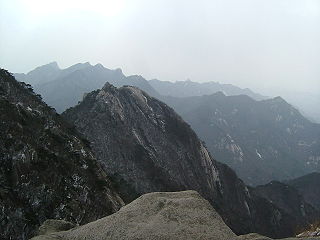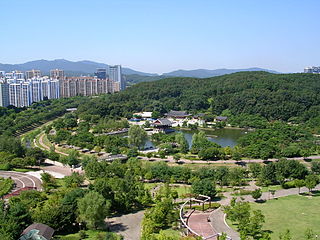 W
WThe Bukhansan National Park in Seoul and Gyeonggi covers an area of 79.92 km2 (30.86 sq mi) and was established on 2 April 1983. Bukhansan means "mountains north of the Han River."
 W
WBundang Central Park is located at the heart of the recently developed residential area, Bundang. It is one of the two big parks in Bundang, the other is Yuldong Park in Bundang-dong. It is 500 meters away from Seohyeon Station.
 W
WEverland is South Korea's largest theme park. Located at the Everland Resort in Yongin, a city in Gyeonggi-do, it receives 5,85 million visitors annually and was ranked nineteenth in the world for amusement park attendance in 2018. Along with its main attractions, Everland includes a zoo and water park known as Caribbean Bay. Everland is operated by Samsung C&T Corporation, which is a subsidiary of the Samsung Group.
 W
WEverland Resort is a theme park and vacation resort located in Yongin, Gyeonggi-do, South Korea. It is owned and operated by Samsung Everland. The resort opened on April, 1976, as a single theme park (Everland), but developed into a resort with water parks, hostels, speedways, golf course and museums.
 W
WThe Garden of Morning Calm (Korean: 아침고요수목원) is an arboretum located at the east of Seoul, in the Gapyeong district of South Korea. On 300,000 m², it houses 5,000 species of plants, some rare or endangered and attracts 600,000 tourists per year. The name of this garden reminds that Korea is often nicknamed the "country of the morning calm". There are different festivals in this garden, especially in winter with a light festival.
 W
WIlsan Lake Park is a city park in Janghang-dong, Ilsan-gu district, Goyang city, Gyeonggi-do Province, South Korea.
 W
WImjingak, and sometimes in English called the Imjingak resort, is a park located on the banks of the Imjin River in the city of Paju, South Korea. The park has many statues and monuments regarding the Korean War. There is also a restaurant, an observation deck, a pool in the shape of the Korean peninsula, and even a small amusement park.
 W
WNamhansanseong is a historical mountain fortress city 25 km southeast of Seoul, South Korea. It sits approximately 480 m above sea level and is aligned with the ridges of the mountain for maximum defensibility. The fortress, stretching 12 km in length, protects a vast area used as an emergency capital city during the Joseon Dynasty of Korea (1392–1910). The design is based on fortress architecture of East Asia, embodying aspects of four historical cultural styles: the Joseon of Korea, the Azuchi-Momoyama Period of Japan, and Ming and Qing China. It was extensively developed during the 16th to 18th centuries, a period of continuous warfare. The technical development of weaponry and armaments during this period, which saw the use of gunpowder imported from Europe, also greatly influenced the architecture and layout of the fortress. Namhansanseong portrays how the various theories of defense mechanisms in Korea were put to form by combining the everyday living environment with defense objectives. The fortress indicates how Buddhism played an influential role in protecting the state, and it became a symbol of sovereignty in Korea. It stands on the Namhansan, containing fortifications that date back to the 17th century and a number of temples. It can be accessed from Seoul through Namhansanseong Station of Seoul Subway Line 8.
 W
WThe Pureun Arboretum is located at 43 Hang-dong, Guro-gu. It is the first arboretum in Seoul that opened in 2013.
 W
WPyeongchon Central Park is a public park in the central part of Dongan-gu, Anyang in Gyeonggi-do, South Korea. Pyeongchon Central Park was opened on 31 December 1993 with a total space of approximately 119,843 square metres (1,289,980 sq ft).
 W
WSeoul Grand Park is a park complex to the south of Seoul, South Korea, in the city of Gwacheon (과천시).